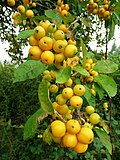| Malus baccata | |
|---|---|
 | |
| Scientific classification | |
| Kingdom: | Plantae |
| Clade: | Tracheophytes |
| Clade: | Angiosperms |
| Clade: | Eudicots |
| Clade: | Rosids |
| Order: | Rosales |
| Family: | Rosaceae |
| Genus: | Malus |
| Species: | M. baccata |
| Binomial name | |
| Malus baccata | |
| Synonyms [1] | |
| |
Malus baccata is an Asian species of apple known by the common names Siberian crab apple, [2] Siberian crab, [3] Manchurian crab apple and Chinese crab apple. [4] [5] [6] It is native to many parts of Asia, but is also grown elsewhere as an ornamental tree and for rootstock. It is used for bonsai. It bears plentiful, fragrant, white flowers and edible red to yellow fruit of about 1 cm (3⁄8 in) diameter.


